

Sacred Stone of the Southwest is on the Brink of Extinction

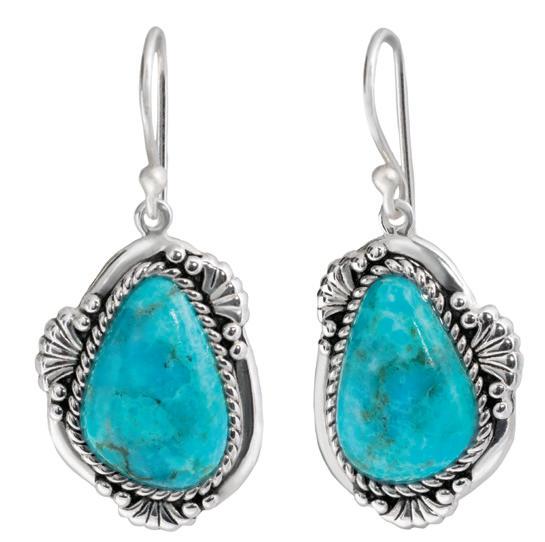
Centuries ago, Persians, Tibetans and Mayans considered turquoise a gemstone of the heavens, believing the striking blue stones were sacred pieces of sky. Today, the rarest and most valuable turquoise is found in the American Southwest–– but the future of the blue beauty is unclear.
On a recent trip to Tucson, we spoke with fourth generation turquoise traders who explained that less than five percent of turquoise mined worldwide can be set into jewelry and only about twenty mines in the Southwest supply gem-quality turquoise. Once a thriving industry, many Southwest mines have run dry and are now closed.
We found a limited supply of turquoise from Arizona and purchased it for our Sedona Turquoise Collection . Inspired by the work of those ancient craftsmen and designed to showcase the exceptional blue stone, each stabilized vibrant cabochon features a unique, one-of-a-kind matrix surrounded in Bali metalwork. You could drop over $1,200 on a turquoise pendant, or you could secure 26 carats of genuine Arizona turquoise for just $99.
Your satisfaction is 100% guaranteed. If you aren’t completely happy with your purchase, send it back within 30 days for a complete refund of the item price.
The supply of Arizona turquoise is limited, don’t miss your chance to own the Southwest’s brilliant blue treasure. Call today!
Jewelry Specifications:
• Arizona turquoise • Silver-finished settings
Sedona Turquoise Collection
A. Pendant (26 cts)
B. 18" Bali Naga woven sterling silver chain $149 +s&p
C. 1 1/2" Earrings (10 ctw)
Set
* $99 +s&p Save $200
**Complete set includes pendant, chain and earrings.


Ruralite
November 2024 • Volume 72, No. 11
CEO Michael Shepard
SENIOR VP OF CONTENT Leon Espinoza
EDITORIAL DIRECTOR Mike Teegarden, CCC
DEPUTY EDITORIAL DIRECTOR
Noble Sprayberry
SENIOR EDITOR Jennifer Paton, CCC
ASSISTANT EDITORS Chasity Anderson, CCC; Victoria Hampton, CCC; David Herder, CCC
ASSOCIATE EDITORS
Valeri Pearon, Nina Todea
PUBLICATIONS PRODUCTION SR. MANAGER
Elizabeth Beatty
SENIOR PUBLICATIONS COORDINATOR
Alyssa McDougle
Ruralite (USPS 397-460) is published monthly for members for $5.43 per year, plus postage, by Pioneer Utility Resources Inc., 5625 NE Elam Young Pkwy. Ste. 100, Hillsboro, OR 97124—a not-for-profit Oregon cooperative corporation—to serve the communication needs of 46 consumer-owned electric utilities in Oregon, Washington, Alaska, Idaho, Nevada and California. Preferred periodical postage paid at Hillsboro, Oregon, 97123 and additional mailing offices. © 2024 Pioneer Utility Resources. All rights reserved. Reproduction in whole or in part without written permission is prohibited.
Postmaster: Send address changes to Ruralite, 5625 NE Elam Young Pkwy. Ste. 100, Hillsboro, OR 97124-6454
HOW TO CONTACT RURALITE
Subscription services:
Nonmember subscriptions $15 (U.S.) per year; $25 per year (foreign). Prepayment required. Allow 4-8 weeks for first issue. Be sure to identify which local edition you want to receive.
Address Changes:
Utility members, contact your local utility. Subscribers, call us at 503-357-2105 option 3 or email mailingdept@pioneer.coop.
Back issues:
Back issues and extra copies $3. Prepayment required. Supply is limited. Be sure to identify edition, month and year. Call first if ordering back issues to check availability.
To contact Ruralite: Ruralite magazine is published by Pioneer Utility Resources. P.O. Box 1306, North Plains, OR 97133-1306; 503-357-2105; email: info@pioneer.coop. For more information, visit www.pioneer.coop.
DISPLAY ADVERTISING INQUIRIES
American MainStreet Publications 611 S. Congress Ave., Ste. 504 Austin, TX 78704
800-626-1181 or 512-441-5200
This Is the Last One—For Me
See that young guy on the left? That is me more than 30 years ago on my first trip for this magazine. I was ambitious, energetic and excited about embarking on a new career as an assistant editor at a magazine, my dream job. Today, I am writing my last column before retiring at the end of the year. What a glorious ride it has been.


During my time, I have traveled to places I only dreamed of seeing. I spent a week on a tug-and-barge off the coast of Alaska. I traveled to Guatemala, where I spent three weeks photographing lineworkers bringing electricity to a small community for the first time. I have been in small, rural Alaskan villages only accessible by plane, boat or sled. I have covered forest fires in Oregon and a plucky young barrel racer in Arizona who is paralyzed from the waist down. I’ve been hoisted 70 feet in the air in a bucket truck and flown in a hot air balloon. And I have attended countless utility annual meetings, talking with readers like you.
In the past few years, I’ve received many calls, letters and emails from you. Some of you were grateful for a story or hopeful I would publish

For supplemental and interactive content, search @Ruralite on your favorite social media sites.
one. Others took exception to something in the magazine or found an error you thought I should know about.
A few of you sent me milkweed seeds in my quest to create a monarch butterfly habitat.
I appreciate your passion about what is printed each month. You have kept me on my toes. Thank you. My success here is due to two factors: The support of my wife and kids when I worked long hours and traveled at inopportune times; and through the support of a wonderful team of friends who do amazing work every day. I wish I had room to list each one of you, but you know who you are.
Starting next month, Chasity Anderson takes over duties as editorial director. She is a friend and someone I have great respect for. I know she will serve you well.
And now, friends, I say goodbye. I hope you continue to be faithful readers.
Farewell,
Mike Teegarden Editorial Director

From Service to Leadership
Air Force veteran continues to lead in local and state VFW Up Close, Page 10
Sleep in Heavenly Peace
Volunteers build beds so no child has to sleep on the floor
Are You the One?
Consider running for the GVEA Board of Directors
By Deb Hickok
“Serving on the GVEA board is important because, as a democratically controlled organization, the board really does set the long-term strategic plan,” says Tom DeLong, GVEA board chair.
The impact of GVEA is also personal.
“As soon as there is a power outage, you quickly learn that GVEA is the most important organization in the service area,” Tom says.
Tom’s enthusiasm for participating in the electric cooperative’s growth and transformation has not waned during his 19 years of service on the board.
He is also keen on encouraging GVEA members to consider running to be a board director.
The service area for the not-for-profit rural electric cooperative is divided into seven geographical districts. Each district has a director who is elected by the general membership to serve a three-year term on the board. There are no term limits.
Elections for the directors of districts 5 and 6 will take place this spring, and that process has already started. See sidebar “How to Apply for the GVEA Board” for more information on which locations these districts cover as well as the process to become a director.
“You’re from a district, but you make the decision on the best outcome for the entire membership and the utility,” Tom says, who is the director for district 2.
GVEA serves nearly 100,000 Interior residents in Fairbanks, Delta Junction, Nenana, Healy and Cantwell. Service also extends to Interior residents out to 48-mile Steese Highway, 11-mile Elliot Highway—known as Haystack Subdivision—and 26-mile Chena Hot Springs Road.
“Serving on the GVEA board helps to provide a voice to people that are similar to you in your area and have an impact on something that they use day in and day out,” GVEA Chief Executive Officer Travis Million says.
Shaping the Region’s Energy Landscape
“A person has a tremendous responsibility as a board member,” Tom says. “At times, it’s overwhelming.”
GVEA is accountable for operating and maintaining 3,261 miles of transmission and distribution lines, 35 substations and nine generating facilities. Directors hold the responsibility for managing this multi-million-dollar business with current assets of nearly $744 million and an annual operating income of $270 million.
“Some of the decisions we make are legacy decisions that have long-term implications for the cooperative,” Tom says.
He cites the gravity of adding a new power plant as an example. The board has to consider many factors, such as risk management and cost, pertinent to a project that can be a 20- to 40-year investment for its members.

to take the organization to ensure success in the future.”
In addition to longterm planning, key duties of a director include governance, like setting operational policies, and ethical, fiscal and regulatory oversight.
Working collaboratively with other board members is another asset.
specific GVEA member about a specific concern. Since he cannot get involved with operational matters, Tom will communicate the item to the CEO, who will have the concern examined and resolved.
Another way that the board listens to GVEA members is by welcoming comments at the beginning of the agenda of its regularly scheduled meetings.
“Our board is extremely detailedoriented,” Tom says, while noting the time required to understand complex issues.
Tom says that making monumental decisions for the cooperative requires deliberation, study and controversy.
“A more diverse board makes better decisions,” Tom says. “It is important to promote inclusivity, so GVEA represents all demographics.”
What a Director Is and Is Not
“The board helps set the strategic direction that GVEA takes in the future,” Travis says. “And provides direction for me
“In the area of governance, Golden Valley has a stellar record for its policies compared to the almost 900 other electric cooperatives around the country,” Tom says, from his conversations with peers involved in other co-ops.
“It is important to not cross the line into operational and personnel issues,” Tom says. “That’s not the board’s purview.”
As an example, the board is responsible for the selection and evaluation of only one GVEA employee, the CEO.
The board also does not get directly involved in day-to-day operations. For example, Tom may receive a call from a
How to Apply for the GVEA Board
Directors on the GVEA board are elected by the general membership. While ballots go out and online voting opens in early May, the process has already begun. The nominating committees are being formed, and training of its members is already scheduled.
Directors for districts 5 and 6 will be elected in 2025.
District 5 includes the area of North Pole; the Richardson Highway from Mile 352 and the east side of Woll Road, Nordale Road, the area north of Chena Slough, Moose Creek, Eielson, and south to the Salcha River. District 6 comprises Delta Junction, Fort Greely and all areas south of the Salcha River, including Harding and Birch Lakes.
There are two paths for a GVEA member to be added to the ballot. One path is to be nominated by committee and the other is to be nominated by petition.
In either case, a candidate must have a GVEA membership in their name for the district seat they seek to pursue. Secondly, the candidate is responsible for obtaining a personal background check report from the Alaska State Troopers to include as part of their application.
“One of the most important qualifications to be a board member is having the time to serve.”
The Willingness to Learn Is a Key Attribute of a Director
Travis says that while business and financial experience are definitely assets for a prospective board director, these attributes are not required or necessary.
“Their involvement and desire to learn and to help make a difference is huge,” Travis says. “Anyone who is interested can be a great board member if they are willing to learn about the intricacies of the utility.”
Tom brings to the board his background in geology, mining, fishing, and small
If choosing to go through the process via the nominating committee, a candidate must submit an application to the committee by January 22 at 5 p.m.
Candidates, including incumbents, who have completed the application and meet the eligibility requirements, will be interviewed by the committee. The committee will submit their nominations by February 21.
If choosing to pursue a director’s seat through nomination by petition, a candidate must secure verified signatures from 50 members in their district or 3% of the total district membership, whichever is less. A nominee must submit the written petition signature form along with their completed application to GVEA by March 5 at 9 a.m.
GVEA will mail director election ballots to every cooperative member and open online voting on May 9. Ballots must be returned or cast online by June 10 at 5 p.m.
The GVEA Board of Directors will formally accept the election results at its June 24 meeting.
For complete information on how to apply to be a director, go to the GVEA website at www.gvea.com/elections.
business skills in owning and operating Tolovana Hot Springs. He takes full advantage of the opportunities for a formal education about the energy industry and cooperative governance.
The GVEA bylaws requires directors obtain the National Rural Electric Cooperative Association’s Credentialed Cooperative Director designation within 2.5 years of becoming a director.
“CCD is a very intense weeklong training that covers anything that a board member would need to know to be involved in a successful co-op,” Travis says.
The director must attend five required courses and successfully complete a learning assessment for each course.
The sessions cover the topics of director duties and liabilities, understanding the electric business, board operations and process, strategic planning and financial decision-making.
highest level of education, Director Gold, of a three-tiered system offered by the national association.

The NRECA also offers continued education after the initial designation. The Board Leadership Certificate typically includes more than 20 courses of study.
“I am a true, true utility nerd,” Tom says. He has attained the
He works to update and broaden his education. A director has the opportunity to attend workshops, training and conferences. Either in one-on-one or organized meetings, a director also has many occasions to absorb and dissect the analysis of issues by GVEA’s professional staff.
Furthermore, Tom is an avid reader on industry trends.
“The electric industry right now is going through a radical transformation driven by technology, economics and carbon emissions,” Tom says. “It’s a pretty darn interesting and exciting time.”
Tom has extensively studied installations of wind, solar and battery combinations in Texas. He says that issues presented by climate change—such as wildfires, winter rain, permafrost melting and vegetation growth—are also areas of investigation for the cooperative.
“If you’re willing to learn, there are plenty of opportunities for education,” Travis says. n

Statement of Nondiscrimination
In accordance with Federal civil rights law and U.S. Department of Agriculture (USDA) civil rights regulations and policies, the USDA, its Agencies, offices, and employees, and institutions participating in or administering USDA programs are prohibited from discriminating based on race, color, national origin, religion, sex, gender identity (including gender expression), sexual orientation, disability, age, marital status, family/parental status, income derived from a public assistance program, political beliefs, or reprisal or retaliation for prior civil rights activity, in any program or activity conducted or funded by USDA (not all bases apply to all programs). Remedies and complaint filing deadlines vary by program or incident.
Persons with disabilities who require alternative means of communication for program information (e.g., Braille, large print, audiotape, American Sign Language, etc.) should contact the responsible Agency or USDA’s TARGET Center at (202) 720-2600 (voice and TTY) or
contact USDA through the Federal Relay Service at (800) 877-8339. Additionally, program information may be made available in languages other than English.
To file a program discrimination complaint, complete the USDA Program Discrimination Complaint Form, AD-3027, found online at https://www.usda.gov/oascr/ how-to-file-a-program-discrimination-complaint and at any USDA office or write a letter addressed to USDA and provide in the letter all of the information requested in the form. To request a copy of the complaint form, call (866) 632-9992. Submit your completed form or letter to USDA by:
mail: U.S. Department of Agriculture Director, Center for Civil Rights Enforcement 1400 Independence Avenue, SW Washington, D.C. 20250-9410; or fax: (833) 256-1665; or email: program.intake@usda.gov.
De acuerdo con la ley federal de derechos civiles y las reglamentaciones y politicas de derechos civiles del Departamento de Agricultura de Estados Unidos (U.S. Department of Agriculture, USDA), se prohibe al USDA, sus agendas, oficinas y empleados, e instituciones que participan o administran los programas del USDA, discriminar por motivos de raza, color, origen nacional, religión, génera, identidad de génera (incluidas las expresiones de génera), orientación sexual, discapacidad, edad, estado civil, estado familiar/parental, ingresos derivados de un programa de asistencia pública, creencias politicas, o reprimendas o represalias por actividades previas sobre derechos civiles, en cualquier programa o actividad Ilevados a cabo o financiados por el USDA (no todas las bases se aplican a todos los programas). Las fechas limite para la presentación de remedios y denuncias varían según el programa o el incidente.
Las personas con discapacidades que requieran medios alternativos de comunicación para obtener información sobre el programa (por ej., Braille, letra grande, cinta de audio, lenguaje americano de señas, etc.) deberán comunicarse con la Agenda responsable o con el Centro
GVEA is an Equal Opportunity Employer and Provider. GVEA esta institución es un proveedor de servicios con igualdad de oportunidades.
TARGET del USDA al (202) 720-2600 (voz y TTY) o comunicarse con el USDA a través del Servicio Federal de Transmisiones al (800) 877-8339. Asimismo, se puede disponer de información del programa en otros idiomas además de inglés.
Para presentar una denuncia por discriminación en el programa, complete el Formulario de denuncias por discriminación en el programa del USDA, AD-3027, que e encuentra en linea en https://www.usda.gov/oascr/howto-file-a-program-discrimination-complaint, o en cualquier oficina del USDA, o escriba una carta dirigida al USDA e incluya en la carta toda la información solicitada en el formulario. Para solicitar una copia del formulario de denuncias, Ilame al (866) 632-9992. Envíe su formulario connpletado o su carta al USDA por los siguientes medios:
correo: U.S. Department of Agriculture Director, Center for Civil Rights Enforcement 1400 Independence Avenue, SW Washington, D.C. 20250-9410; o fax: (833) 256-1665; o correo electronico: program.intake@usda.gov.

GVEA Member Spotlight
Helping Our Neighbors During the Holiday
Fairbanks Community Food Bank’s Thanksgiving Food Box Program
By Rachael Kvapil
The Fairbanks Community Food Bank Service Inc. manages many food assistance programs during the year. However, the most visible program comes at the start of the holiday season. The Thanksgiving Food Box contains donated holiday food items for families to prepare a traditional Thanksgiving meal. The Fairbanks Community Food Bank is currently requesting donations and seeking volunteers in preparation for distribution later this month.
“We want to make sure that no family goes to bed hungry on Thanksgiving,” says Sam Kirstein, community development director of the Fairbanks Community Food Bank.
The food bank was started in 1982 by a small group of people who decided it made no sense to have a surplus of community food and still have hungry families. After doing some research, they discovered that a food bank could collect the surplus food from the grocery stores and then distribute it to people in need. The operation has grown and moved locations throughout the ’80s and ’90s, to assist as many local families with food insecurity as possible.
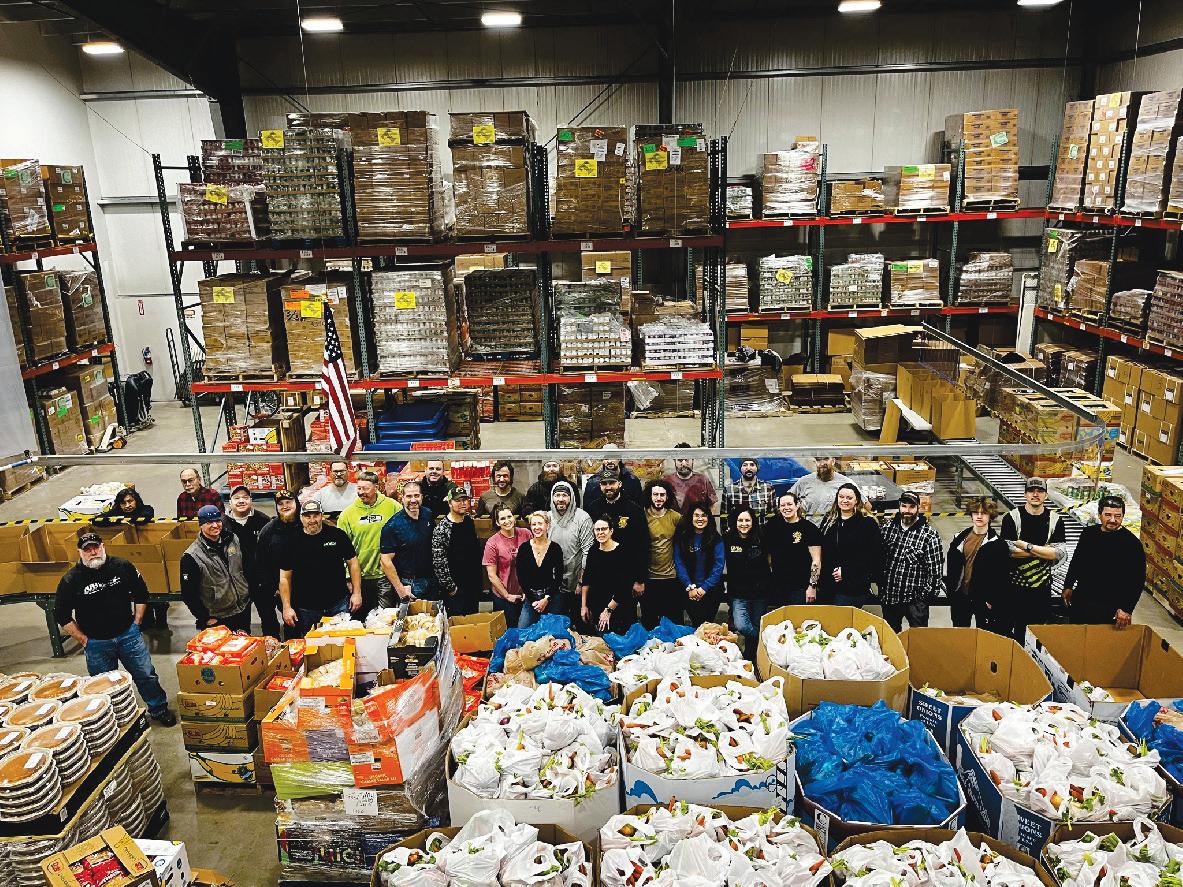
Sam says last year, the Fairbanks Community Food Bank provided 2,800 Thanksgiving Food Boxes to families. This year, 3,300 households are expected to be served Thanksgiving Food Boxes as families struggle with inflation and an overall difficult economy.
“I’m always concerned when we set our numbers,” Sam says. “But with the help of our generous community, we’ve always been able pull it off.”
There are several ways to donate. Monetary donations are easily made by going to the Fairbanks Community Food Bank’s website, fairbanksfoodbank.org, and clicking on the “Donate Here” button on top. Money will fund Thanksgiving items purchased by volunteer shoppers. Donors can participate in food drives at local markets and throughout the community. People can also buy items and drop them off at the Fairbanks Community Food Bank at 725 26th Ave. or call 907-457-4273 to arrange pickup.
Thanksgiving Food Boxes generally include meat, potatoes, carrots, canned goods, handmade bread and other delicious treats. If buying during a market food drive, shoppers will be presented with a list of suggested items for the boxes. However, Sam says people can also call prior to shopping to find out what items are still needed.
In addition to donations, volunteers play an important role in sorting, packing and transporting boxes for distribution on November 22.
“Many businesses and organizations arrange for groups of employees to volunteer during the holiday seasons,” Sam says. “We appreciate the hard work of all our volunteers who work together to make this happen.”
The Thanksgiving Food Box is just one of the many food assistance programs available at the Fairbanks Community Food Bank. The Christmas Food Box program kicks into gear immediately after the Thanksgiving holiday, and many other programs run year-round. The holidays are when food and financial donations reach their peak, with the lowest contributions occurring in the spring and fall. However, hunger is a constant reality for many Fairbanks residents, so Sam encourages community members to give when possible. n















































From Service
Air Force veteran continues to lead in local and state VFW
By Melanie Jones
“It’s not a man’s world,” Carol Kacal says.
The Air Force veteran has been breaking glass ceilings for decades.
For 20 years, Carol served her country. Her service included a six-month stint in Turkey, where she held a leadership role. She says meeting all the different people and making lasting friends was a favorite part of her service.
the Air Force seemed like a good fit. She signed up at 18 and got her wish.
Along with assignments stateside in Missouri, Arizona and Colorado, Carol served in Guam, Germany, Korea and Turkey before her last assignment in Alaska. She liked it so much that she stayed after putting in her 20 years.
Carol says one of her most interesting stops was in Turkey, where she oversaw supplies and equipment coming in and out of the country for the Army and Air Force.



to Leadership
in and take advantage of the different opportunities provided,” is her advice for anyone considering serving in the military.
But Carol has specific words of wisdom for women.
“Females need to work alongside others, not behind or think they are better or worse,” she says. “The big thing is learning to be a team.”
This holds true in the military and out.
Carol earned the right to join the VFW while serving in Korea. In the past, many women veterans chose to join the women’s auxiliary instead of the VFW itself, even though they had served in the military. Now, not only are more women joining, but more are serving in leadership roles.
“Joining the VFW brings camaraderie among people who have been in military situations together,” Carol says. “We pull together and are able to stand up for veterans’ rights that we’re promised when we sign the dotted line.”
Carol serves as quartermaster for VFW Post 10029 in North Pole.
“I believe in helping the veterans and their families,” she says.

One thing Carol is always proud to do is ensure there are flag lines for soldiers to walk through when they return home. She says some people at airports seem to think they are blocking servicemen and women from seeing their families when they get off their planes, but that’s not the intent. Organizers want to ensure that when service members step into the airport returning from their stations, all they see is a wall of U.S. flags.
Life isn’t all about the VFW, though. Serving in accounting and budgeting in the Air Force prepared Carol for her current job as an accounting assistant at Design Alaska.
There were a few struggles when she first left the military, though. For one thing, deciding what to wear was a hassle after 20 years of wearing a uniform almost every day. Another was keeping track of time.
“Now I work on an hourly basis, not on call 24/7,” she says.
Veterans Day is special for Carol. She and her veteran husband of 19 years, David, work with a second grade class
that holds a special program for veterans each year. They previously held the event at the VFW post, but it grew so large, they must hold it at the Moose Lodge in Fairbanks.
Last year, about 75 students performed a program for about 20 or 30 veterans, with parents and others in attendance. Recently, the students presented veterans with a flag with all their handprints on it.
Carol isn’t sure why there are so many women veterans in Alaska—it’s tied with Virginia for the greatest proportion—but she does know there are many dualenrollment couples in the state, meaning both spouses served in the military.
Regardless, Carol loves calling Alaska home and enjoys camping with David and playing with their cat and dog. The couple have three children and six grandchildren. When she’s not outside, working or helping other people, Carol enjoys doing puzzles on her computer and encouraging other women to join VFW.
“You have that right just as much as (men) do to be a comrade,” she says. “We have served side by side.” n

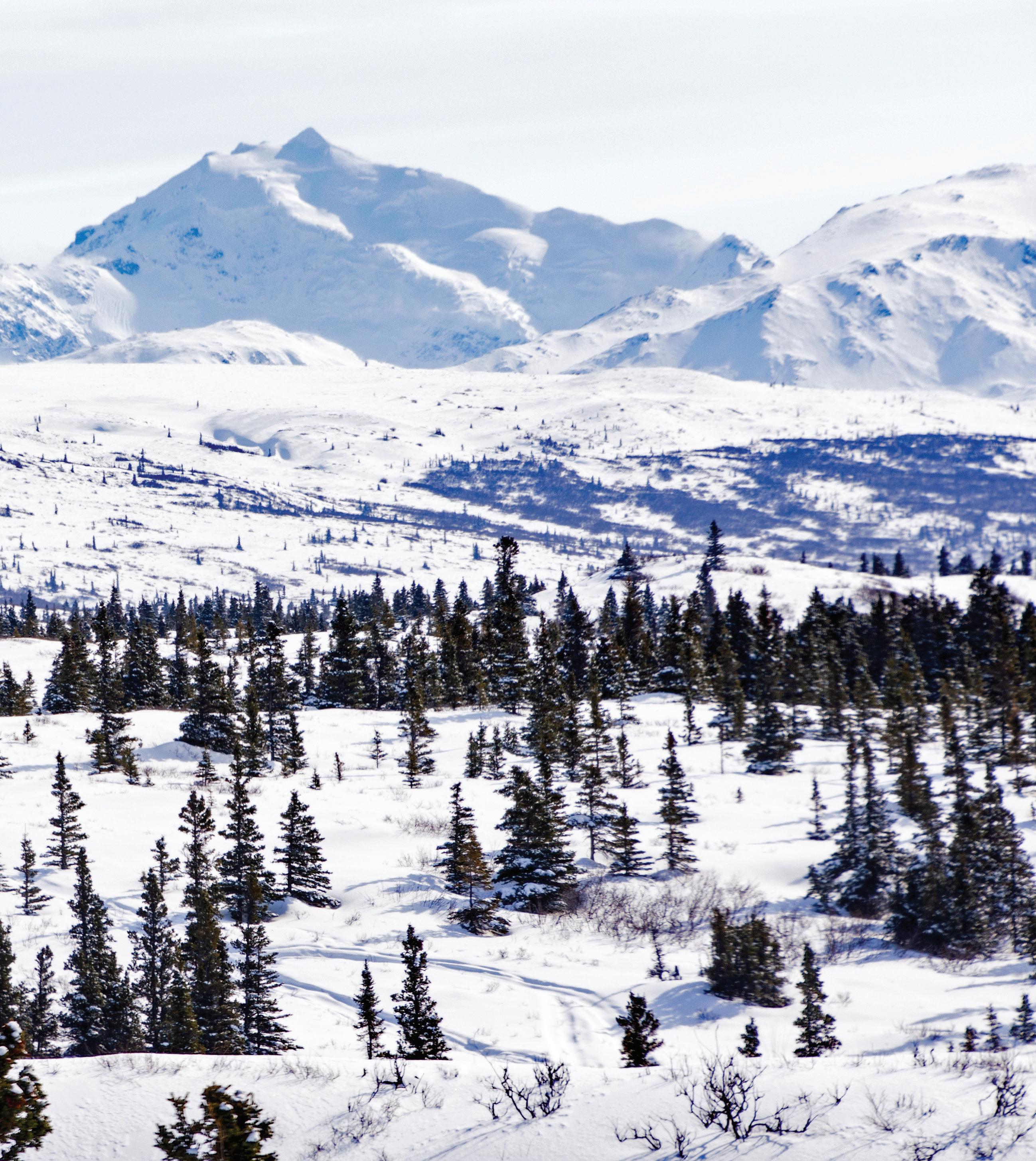
Sleep in Heavenly
Volunteers build beds so no child has to sleep on the floor
By Ginger Meurer
A joyful chorus from excited children greets the chapter members of Sleep in Heavenly Peace Nye County, Nevada, as they deliver seven beds to a Pahrump home. The number is just one shy of the organization’s record.
“When we came, they had nothing,” says Nye County Chapter President Carmen Murzyn. “Tonight, they all get to sleep in their own beds.”
Volunteers hauling headboards, railings, mattresses, bedding and tools stream in the door and up the stairs—home to children ranging in age from 6 months to 15 years old. The house is empty except for a television, a camping mattress and a few blankets.
The children’s mother said they moved from Las Vegas in search of a better job and more affordable housing. Her previous landlord wanted $3,000 a month for their apartment.
“I finally gave up and said, ‘I can’t afford it,’” she says.
Without a truck or funds for the move, the family left most of
their belongings behind and started over in Pahrump.
Chapter Delivery Manager Steve Filarowski and Chapter Build Manager Jim Murzyn—Carmen’s husband—assemble the wooden beds with power tools.
“They’re so basic, but they’re built well,” Jim says. “They’re solid. In this case, it’s the only piece of furniture in the house, but a lot of times they’re the nicest piece of furniture in the house.”
Jim and Steve say the basic components of the beds make them easy to assemble and sturdy.
“If we ever have an earthquake, I’m getting under one of these,” Jim says.
“They’re really built to last,” Steve adds.
Interested children can assist with assembly. On this day, only the oldest braves the screech of the power tools. Jim and Steve help her safely guide the screws into her bunk.
“Don’t be afraid of it! You’re doing good,” Jim says as she pushes the driver trigger. “It just makes noise.”
Once the beds are up, Carmen and volunteers Marjorie

Heavenly Peace

Washington and Charmayne Fazackerley help the children choose bedding. They unroll mattresses and teach them how to make their beds.
Deliveries like this tap the talents of Sleep in Heavenly Peace volunteers in more than 300 chapters in four countries united by one mantra: “No kid sleeps on the floor in our town.”
SHP founder Luke Mickelson says his first delivery in December 2012 melted his heart and left him resolved to do more. He built a set of bunks with a young men’s church group for a family in their Twin Falls, Idaho, congregation. After that, he built a bed with his family and delivered it to Haley, a 6-year-old girl who was in a new home with her mom after being homeless and sleeping in the backseat of their car.
“We went into little Haley’s bedroom, and there was a pile of clothes in the corner, and that’s what she slept on,” Luke says.
Haley’s joy and her mother’s tears of relief were eye-opening. Back then, it took hours to build a bed, but Luke realized there was nothing more worth his time.
“We ended up doing 22 beds before Christmas that year,” Luke says. “It was awesome.”
The next December, he got more people involved. In 2014, he set up a nonprofit because people wanted to donate to the cause. In 2015, Luke and his friend, now SHP Executive Director Jordan Allen, decided instead of just building at Christmas and for a few
Eagle Scout projects here and there, they should host builds all year. There were 15 build days that year.
Soon, SHP got calls from volunteers from Minnesota to Maryland who wanted to build beds in their hometowns. So, they flew people into Idaho to train them and help them form new chapters. By the end of 2017, they had chapters in five states and more on the way.
That’s when Mike Rowe of TV’s “Dirty Jobs” fame featured
Sometimes you have to be willing to challenge yourself to do more than you think you can do.
—Jim
Prior,
co-president of the SHP Eugene Chapter
them on his “Returning the Favor” Facebook Watch series. Mike leveraged community support for a rent-free warehouse for SHP for three years.
“But the biggest thing that came from that is we were viewed by 10 million people,” Luke says.
The episode aired Feb. 12, 2018. SHP put together an application for those wanting to start chapters.
“In the first year, we had like 2,000,” Luke says. “A crazy amount.”
SHP swiftly boomed from seven chapters to more than 120. Apart from a slowdown during the COVID-19 pandemic, SHP has consistently added 40 to 50 chapters a year.
Prospective chapter presidents must go to a build and prove they have enough community support to keep their chapters going. Then they fly to Lehi, Utah, for training.
Jim Prior, who serves as co-president of the SHP Eugene Chapter alongside his wife, Jeanette, says training is intense. They’d been involved in SHP for more than four years, so they felt like there was much they understood—but the training gave them much more to learn.
“It was still kind of like drinking from a fire hose,” Jim says. “Even though we knew the general concept of what was going on.”
The Priors took over when Eugene Chapter founders Bryce and Connie Jonas decided to step back a little over a year ago. No one had volunteered to take over, and the Priors



didn’t want to see the area’s needs go unmet.
“I thought, ‘Sometimes you have to be willing to challenge yourself to do more than you think you can do,’” Jim says. “Nobody was really stepping up. And it had been such a great charity. It really gives a hand up and not just a handout to families. So, I said, ‘Welp, let’s keep this going.’”
Jeanette was on board, too.
“Jim and I thought about it and did a lot of praying,” she says. “We didn’t really want to see it go away. We believe in what it does and how it helps kids, and just to see the smiles.”
Jim says raising funds isn’t hard. Once he is in front of an audience, the idea of helping children sells itself. Plus, the dollars raised stay in town. Other than 10% routed to the national headquarters for overhead such as insurance, logistics and website maintenance, every penny raised stays with each local chapter and goes directly into beds for kids.
Luke says only about 4% of the national money is labeled as management, which is “completely unheard of in the nonprofit world, especially for a nonprofit with nearly a $25 million annual budget. We’re pretty proud of that.”
While some builds invite the public to help, using donated funds to cover the $300 to $350 for a bunk, others are sponsored by organizations or businesses and frequently serve as teambuilding exercises. In Eugene, several sponsored builds occur

each year, including builds with coaches and players from the University of Oregon’s athletics programs. A July build brought in nearly 200 coaches, players and volunteers from multiple Oregon chapters who turned out 155 beds in less than four hours.
Nationally, Lowe’s—one of the organization’s biggest sponsors— hosts huge builds with multiple chapters.
The bed-building process has evolved a lot since 2012.
“I used to be on hands and knees trying to square corners,” Luke says. “It would take two hours just to build a bed, let alone sand it and stain it.”
Now, at some of the biggest builds, a bed is completed every 24 seconds.
“It’s crazy,” Luke says. “I like to say Henry Ford would be pretty proud of our assembly line.”
Everyone involved agrees that while building beds is fun, the most important part of the mission is the children.
When the beds were complete at the Pahrump home, 3-yearold Jazita was first to hug her freshly cased pillow and lie down on her new bed. She was speechless when asked what she thought of it, but her smile and expression of “Is this really for me?” were unmistakable.
Carmen isn’t surprised by Jazita’s reaction. Before the delivery, she talked about what it’s like when kids get their own beds.
“It’s like it’s their own space,” she says. “It’s their place; it’s nobody else’s. We’ve had quite a few kids get right in, and they’re already going to sleep before we’re out the door. The kids will jump in their bed no matter what time it is.”
Even though it was only 4 p.m., that’s exactly what Jazita did. n
For more information on volunteering or to apply for a bed, visit shpbeds.org.

Flavors of Fall
Leftover Turkey and Dumpling Soup
Olive oil, as needed
1 large onion, sliced
2 medium carrots, peeled and diced
2 celery stalks, diced
½ cup frozen peas
2 sprigs fresh sage
2 sprigs fresh thyme
2 bay leaves

2½ quarts turkey or chicken stock
2 cups all-purpose flour
2 teaspoons baking powder
1 tablespoon sugar
1 teaspoon salt
1¾ cups heavy cream
1 pound leftover turkey, shredded
Salt and freshly cracked black pepper, to taste
Heat a large, heavy-bottom pot over medium heat. Add enough oil to just coat the bottom. When the oil is hot, add the onion slices. Let them caramelize for about 8 minutes or until golden brown, stirring often. Add the carrots and celery. Season with salt and pepper. Saute for about 8 minutes.
Add the sage, thyme, bay leaves and stock. Stir well and bring the liquid to a simmer.
Simmer for about 25 minutes, stirring often. Season the soup with salt and black pepper, to taste.
Meanwhile, combine the flour, baking powder, sugar and salt in a mixing bowl. Stir to combine. Stir in the heavy cream until just incorporated. Don’t overmix. The dough should be somewhat lumpy.
Remove the herbs from the soup, and stir in the turkey. Use two spoons to drop the dumplings into the soup in an even layer. Cover the pot, and simmer for 8 minutes. Remove the lid, add the peas, and simmer for 3 minutes.
Serve the soup in large bowls topped with black pepper and any additional herbs.
Pumpkin Mac and Cheese
¼ cup plus 2 tablespoons unsalted butter, divided
3 cloves garlic, grated and divided
½ cup panko breadcrumbs
2 teaspoons kosher salt, divided, plus more for pasta water
¾ teaspoon ground black pepper, divided
1/3 cup grated Parmesan cheese
1 pound dry cavatappi pasta
6 sage leaves
½ medium yellow onion, grated
2 tablespoons flour
1 teaspoon ground mustard
¼ teaspoon ground nutmeg
¼ teaspoon cayenne pepper
2 cups whole milk
15-ounce can pumpkin puree
8 ounces fontina cheese, shredded
8 ounces smoked gouda cheese, shredded
In a small nonstick skillet, melt 2 tablespoons of butter over medium heat. Add 1 grated garlic clove. Cook until fragrant, about 30 seconds. Stir in the breadcrumbs, 1/2 teaspoon salt and ¼ teaspoon pepper. Toast, stirring frequently, until the breadcrumbs are golden brown, about 2 minutes. Remove the mixture to a small bowl. Cool for 5 minutes. Stir in the Parmesan. Bring water to a boil in a large pot. Add the pasta, and salt to taste. Cook, stirring the pasta, until just under al dente, 5 to 6 minutes. Drain the pasta, reserving 1/2 cup of the pasta water. In the same pot over medium heat, melt the remaining ¼ cup of butter. Stir in the sage leaves. Cook, stirring frequently, until the sage is lightly fried and the butter is deeply golden and smells toasty. Move the sage leaves to a paper towel-lined plate, and add the onion to the butter. Cook until the onion is soft and translucent, 3 to 4 minutes. Add the remaining two grated garlic cloves. Cook until fragrant, about 30 seconds.
Whisk in the flour, mustard, nutmeg, cayenne, the remaining 11/2 teaspoons of salt and the remaining 1/2 teaspoon pepper. Cook until the raw flour smell disappears, 3 to 4 minutes. Gradually whisk in the milk until smooth. Whisk in the pumpkin puree. Cook until thick, 5 minutes.
Remove the pot from heat. Gradually add the shredded cheeses, whisking until melted before adding more. Taste for salt.
Fold in the drained noodles, adding pasta water 1 tablespoon at a time until the sauce coats the noodles.
Serve the mac and cheese hot, sprinkled with the toasted panko bread crumbs and crumbled sage.
Apple Butter Cheese Twists
1 cup shredded sharp cheddar cheese
½ cup grated Parmesan cheese
17.3-ounce package puff pastry sheets, thawed
1 large egg, lightly beaten
1/3 cup apple butter
2 teaspoons chopped fresh thyme
Heat oven to 400 F. Line two baking sheets with parchment paper. In a medium bowl, combine the cheeses. Sprinkle a clean work surface with ¼ cup of the cheese blend. Place one puff pastry sheet over the cheese, and sprinkle with another ¼ cup of cheese blend. Use a rolling pin to press the cheese into the pastry. Roll the sheet into a 10-by-14-inch rectangle. Repeat the rolling-out process with a second sheet of puff pastry and 1/2 cup of the cheese blend.
Brush the surface of one pastry sheet with egg wash. Place the other sheet on one of the prepared baking sheets. Brush the surface with the apple butter, maintaining a 1-inch border. Sprinkle with the remaining 1/2 cup of the cheese blend and thyme. Top with the second sheet, egg wash-side down, pressing the layers gently together. Refrigerate the assembled sheet for 30 minutes.
Transfer the chilled sheet to a cutting board. Using a sharp knife, cut the pastry into ¾-inch-wide strips. Transfer the strips to the baking sheets, spacing them at least 1 inch apart. Pinch the ends to close, and twist each end in the opposite direction to create a spiral. If they start to untwist, gently press the ends into the parchment.
Refrigerate the twists for 30 minutes, then brush with more egg wash. Bake until golden brown and crisp, 20 to 25 minutes.
Cool the twists on a wire rack. Serve warm or at room temperature.
Butternut Squash Casserole
2 to 2½ pounds butternut squash
¼ cup whole milk
1 teaspoon vanilla extract
1 cup light brown sugar, packed
Topping
1 cup pecan halves
2 tablespoons unsalted butter, melted
¼ teaspoon salt
2/3 cup unsalted butter, melted
¼ teaspoon ground cinnamon
2 extra large eggs, lightly beaten
2 tablespoons light brown sugar, packed
1/8 teaspoon ground cinnamon
Heat oven to 350 F. Line a baking sheet with parchment paper or aluminum foil. Set aside. Cut the squash in half, lengthwise. Scoop out the seeds and discard. Place the squash cut-side down on the baking sheet. Bake for about 45 minutes or until the squash is tender when pierced with a fork. Allow the squash to cool enough to handle.
Spray a casserole dish with vegetable cooking spray. Set aside. While still warm, scoop out the butternut flesh and transfer to a large mixing bowl. Mash the squash with a potato masher until no chunks remain. Add the milk, vanilla, sugar, butter and cinnamon. Stir until combined. Add the eggs. Fold together until blended.
Pour the mixture into the prepared baking pan. Bake until almost set, about 30 minutes. While the casserole is baking, prepare the topping.
In a small bowl, combine the pecans, melted butter, brown sugar and cinnamon. Stir until coated. Remove the baking dish from the oven, and sprinkle the pecan mixture over the squash. Continue baking until set, about 15 minutes.
READER EXCHANGE
Books/Magazines
I would appreciate any Catherine Cookson books you may have and no longer want.
Marsha King 16637 William Foss Road La Pine, OR 97739
Crafts/Hobbies
I would love any old stamp collections or singles you would like to part with. Thanks in advance.
Rosalie Ferry 109 Raven Lane Careywood, ID 83809-9711
I’m seeking to illuminate my winter days with sparkle therapy. Living with a disability on a fixed income can be challenging, but your gift would bring sunshine. If you're willing to part with unwanted jewelry, components or treasures—for men or women—I’d be thrilled to accept them. Your thoughtfulness would give me a sense of fulfillment and happiness. Thank you in advance. I am forever grateful for your generosity.
Carly Wagner 913 Stillwell Ave. Tillamook, OR 97141
We are starting a respite care and are looking for old jewelry—broken or not— chains, beads, pearls and any items used to make jewelry or crafts for dementia patients. We would really appreciate anything you can give.
Diane Whitley
P.O. Box 1629 Eastsound, WA 98245
Milestones
My mother turns 92 this month. She is the wife of a retired Air Force man who took us all over. On base, she was a Girl Scout leader, VBS teacher and spent a lot of time at our sports events. She spends her days now reading, lunching with her greatgrandchildren and playing games online. It would be such a treat for her to receive wishes for her birthday. Send to Betty West, 1860 17th St., Springfield, OR 97477.
Laura Crowe Springfield, Oregon
My dad turns 94 in December and would be delighted to receive birthday cards. He was born in England and served in the R.A.F. as a navigator. He came to the United States in 1965 and worked in sales until he retired. Since my mom’s passing, he spends his time watching the news and all sports on TV. He does some light gardening and still reads without glasses. His favorite hobby is sampling new beers, so if any readers could make suggestions of a new beer for him to try, he would love that. Send cards to Peter Burgoyne, 5549 Our Lane, Zephyrhills, FL 33542.
Larry Burgoyne Sagle, Idaho
Recipes
I am looking for a recipe for pecan praline fudge. I have one, but it failed both times I’ve used it. Can you help? Thank you in advance.
Pat Moss
P.O. Box 61155 Fairbanks, AK 99706
Submitting Requests Is Free
Thanks
A special thank you to all who contributed to my button collection. Your response was overwhelming, and I deeply appreciate you.
Bette McCarthy Pahrump, Nevada
Thank you to all the Ruralite readers who sent my friend, Elsie Bergold, almost 500 cards for her 105th birthday. We played poker and had cake. She was completely shocked by all the cards and the gifts that were sent from complete strangers. She opened all of her cards and read every one of them. KVAL News did a story on her for the nightly news.
Martha Curl Creswell, Oregon
Thank you to all the wonderful, amazing and kind readers that sent me buttons and my grandfather’s yearbook. It was like Christmas. I received them in packages, boxes and envelopes. Thank you so very much for your time, thoughts and kindness. I am so very thankful to everyone.
Kim Koester Fairbanks, Alaska
Have a happy and safe Thanksgiving!
Send your request—no attachments, please—to readerexchange@ruralite.org or mail to Reader Exchange, 5625 NE Elam Young Parkway, Suite 100, Hillsboro, OR 97124. Fill in the subject line with Reader Exchange. Acceptance, scheduling and editing are at the editor’s discretion. Single requests only, please. No duplicates.
Submissions are handled on a first-come, first-served basis and as space allows. We cannot honor every request. Please affirm you have authorization from all appropriate parties before submitting. By submitting, you indemnify Reader Exchange, Pioneer Utility Resources Inc., its officers, directors, employees, utility clients and insurers from all legal liability incurred by the publication of information.
We no longer accept pen pal requests. You may submit a pen pal request as a Marketplace ad. Marketplace pricing applies. When submitting a milestone request, please send it at least two months before the milestone. Phone numbers will not be published. Email addresses will be published if part of the ad, but you must include a postal address. Requests also must include the name and address of the electric utility that provides your magazine.







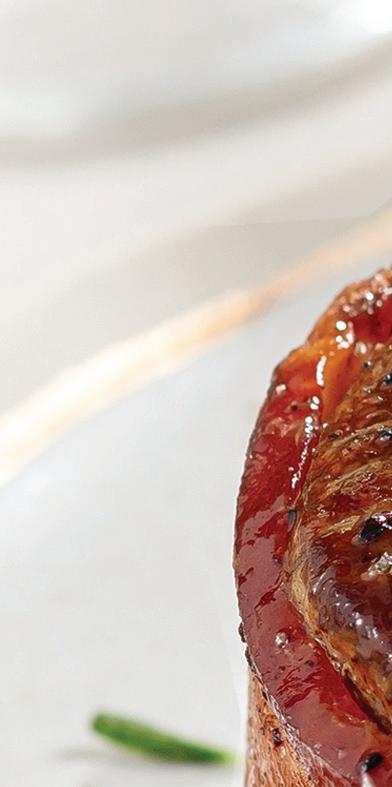



























































See the strength of nature’s architecture in Arizona at
Tonto Natural Bridge State Park

What Is It?
In Central Arizona, just north of Payson, Tonto
Natural Bridge
State Park is home to one of the largest natural travertine bridges in the world. The bridge is 60 feet thick, sits 183 feet off the ground and tops a roughly 400-footlong tunnel that measures 150 feet at its widest point.
Catch Fall Leaves
When visiting, enjoy the short hike down to the bottom of the waterfalls that gently cascade over the bridge and surrounding rocks. The water flowing down from the bridge has created an ideal environment for the aspen, cottonwood and elder trees that brighten the park with magnificent fall colors. While the colors peak in later October, they continue throughout November.
How Was It Made?
The natural bridge is made of a crystalline form of limestone, known as travertine. Broadly, the rock forms when spring water rich in calcium carbonate evaporates, leaving the calcium behind. The calcium built up into a large structure, before a hole was worn through the rock, creating the bridge.
What To Do
In addition to the travertine bridge, the park has four hiking trails, a picnic area, a group use area and the historic Goodfellow Lodge. All trails are shorter than a half-mile, but they are steep and strenuous, so be sure to pack drinking water. The trails close an hour before the park closes, and no dogs are allowed on any of the trails.
More Information
The state park is open daily from 9 a.m. to 5 p.m. but closed on Christmas. On Thanksgiving and Christmas Eve, the park closes at 2 p.m. Admission is $7 for adults, $4 for youth 7 to 13 and free for children 6 and under. If visiting in the winter, be prepared for reduced services. Go to azstateparks. com/tonto for detailed information.






NORTH AMERICA’S









#1 Selling Walk-In


















The best walk-in tub just got better with breakthrough technology! Presenting the all new Safe Step Walk-In Tub featuring MicroSoothe. ® An air system so revolutionary, it oxygenates, softens and exfoliates skin, turning your bath into a spa-like experience. Constructed and built right here in America for safety and durability from the ground up, and with more standard features than any other tub.
✓ Heated seat providing warmth from beginning to end
✓ Carefully engineered hydro-massage jets strategically placed to target sore muscles and joints
✓ High-quality tub complete with a comprehensive lifetime warranty on the entire tub
✓ Top-of-the-line installation and service, all included at one low, affordable price You’ll agree – there just isn’t a better, more affordable walk-in tub on the market.
Someone To Be Thankful For
By Dave LaBelle
Thanksgiving comes in different shapes and is expressed in different ways.
Herb Recker never felt he deserved to take advantage of the Honor Flights that carry veterans to Washington, D.C.
Herb died in January at the age of 71. His Iowa friend, Tom Klaren, who served with him in the Iowa National Guard, carried Herb’s encased flag in May on an Honor Flight.
When veterans gathered at the World War I Memorial in Washington, D.C., they saluted the folded flag Tom brought, which had been given to Herb’s widow, Mary, at his funeral.
“I feel so passionate at what we owe those people, so much of what they gave up,” Tom says. “What their wives gave up, what their mothers and fathers gave up. Sometimes the ultimate sacrifice.
“I am a veteran myself, but not to the point these guys are, who served overseas. I just feel I am a step down from these
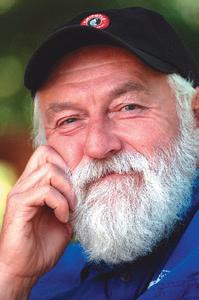
visit davidlabelle.com and bridgesandangels.wordpress.com.
Reader Challenge
As storytellers, we are always looking for fleeting moments that best express the pulse of a story. While I occasionally talk about photo fundamentals, my greatest interest and love is about the psychology of photography.
Perhaps you know a veteran who would agree and even enjoy the attention sitting still for a portrait would bring. Remember, when you make someone’s picture or listen to their story, you are honoring them.
Stay focused and alert. So many times, it is often those ever-fleeting gestures that reveal the most.
guys, that’s how I feel. Actually, Herb felt like I did. Since we were in the National Guard, we felt like we didn’t deserve to go like the guys who actually were in combat.”
Though Tom has made three Honor Flight trips as a guardian for four different veterans, he never made the trip as an “honored” veteran.
Herb and Tom were best friends from grade school, high school and in the National Guard. It was Tom’s honor to carry Herb’s flag to Washington, D.C.
“He was in my wedding, and I was in his wedding,” he says.
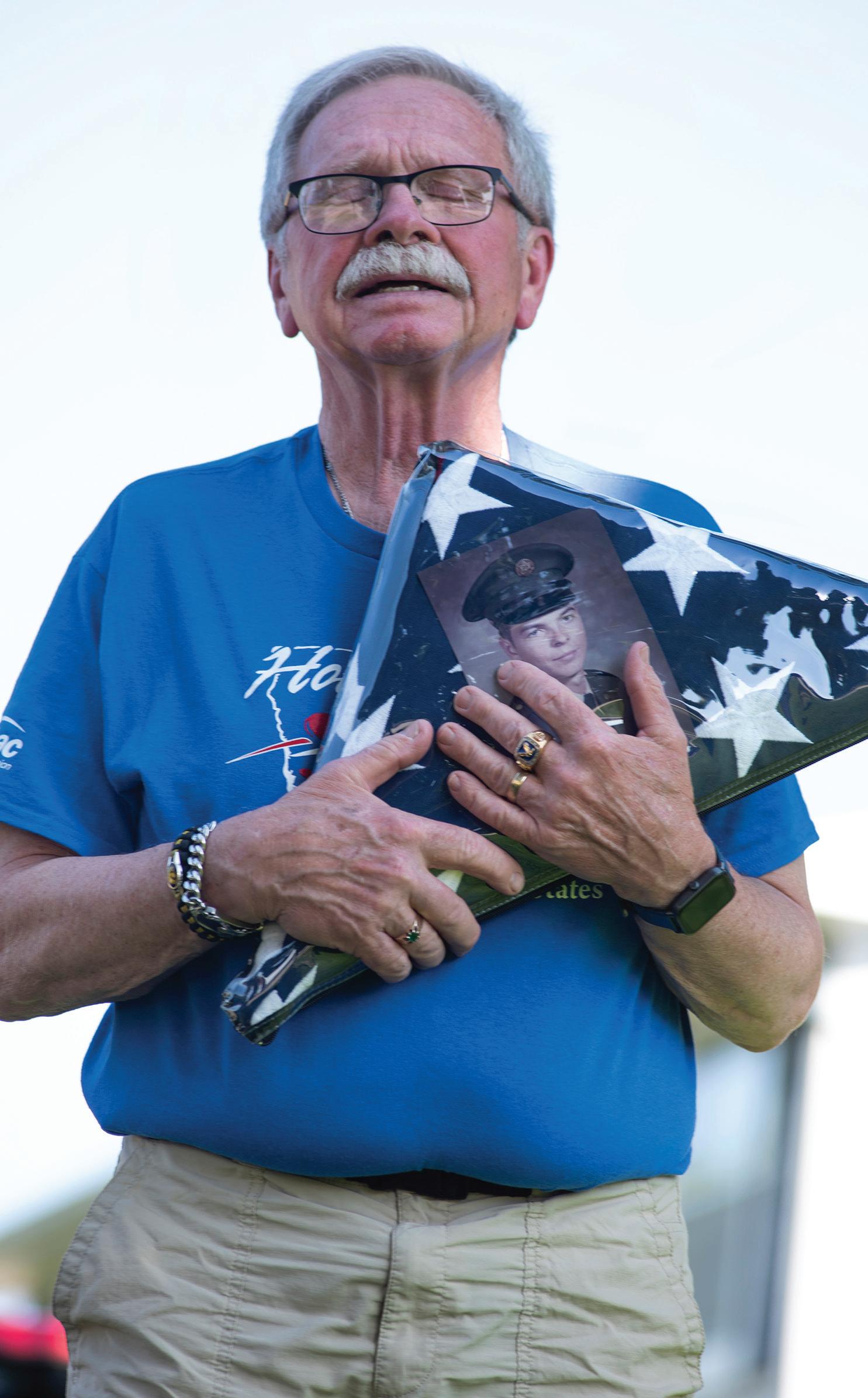
After interviewing Tom, I made several pictures with his best friend’s flag in two different places in his home before asking him to carry Herb’s flag outside on his front lawn. Nothing I shot expressed the emotion this patriotic man felt. Then, after I was finished and sitting on the lawn, Tom grew openly emotional because it had been less than a week after returning from his trip to Washington, D.C. Emotions for Tom were still raw. Looking up, I saw him
relax and drop his guard. A small window opened, and I quickly raised my camera and was able to make two frames before the fleeting moment passed.
Once again, I was reminded of the importance of anticipating the unexpected. Sometimes the best unguarded storytelling moments happen when the formal shoot is over. Deep and buried emotions often surface ever-so-briefly once the camera is off. n
Generational Wealth A future for generations to come




























ea. Minimum order of 5 coins
GENERATIONAL WEALTH is of paramount significance as it represents a beacon of financial stability. It serves as a tangible testament to the hard work, diligence, and financial acumen of previous generations, offering a solid foundation upon which future generations can build their dreams and aspirations.
American Gold Reserve is releasing Government issued $5 Gold American Eagles completely free of dealer mark-up for only $279 each. These beautiful $5 Gold American Eagles are a perfect way to enter the gold market. They are set for immediate public release and will sell out fast.

• Free of dealer markup. • Protection against inflation and deflation. • Gold offers financial cover during geopolitical uncertainty. • Good portfolio diversifier.



















































Poultry Recipes Cookbook
• 24", 28", and 30" clearing widths
• Easy 180 degree turns with 6 forward speeds and 2 reverse




Ruralite reader submissions from this cook booklet features such recipes as Pollo Dorado, Southern Scalloped Chicken, Hawaiian Meatballs, Texas-Style Turkey Salad and Sweet and Sour Chicken.
• Heated hand grips, LED headlights, and rugged chute controls






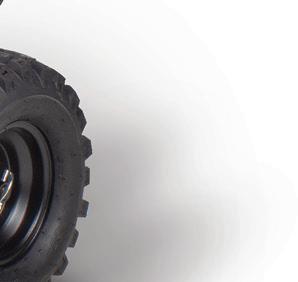















The cookbook is indexed and costs $8 (includes postage).
To order by mail, submit proper payment and include the cookbook title, your name, address and number of cookbooks wanted to Ruralite Cookbooks, P.O. Box 1306, North Plains, OR 97133.
To pay with Visa, MasterCard, Discover card or American Express, call 503-357-2105. To order online, visit www.ruralite.org.
Allow 2-3 weeks for delivery.





Todd Vorisek: New Approaches for Better Solutions
By Rachael Kvapil
Most of the problems GVEA System Analyst I Todd Vorisek, deals with can’t be answered by a simple Google search. His work on GVEA’s computer systems requires a lot of testing and trying things out. It’s a hands-on job requiring curiosity and creativity to get results.
“That’s what I love about the job,” Todd says. “Getting my hands dirty playing with different concepts while I figure things out.”
Todd is a Fairbanks-born problem solver. Growing up in the Interior, he decided to study computer science locally at the University of Alaska Fairbanks. He threw his hat in the ring when an internship with GVEA opened up six years ago. From that internship, he moved into a full-time computer programmer position after graduating college, advancing into his current position two years ago.
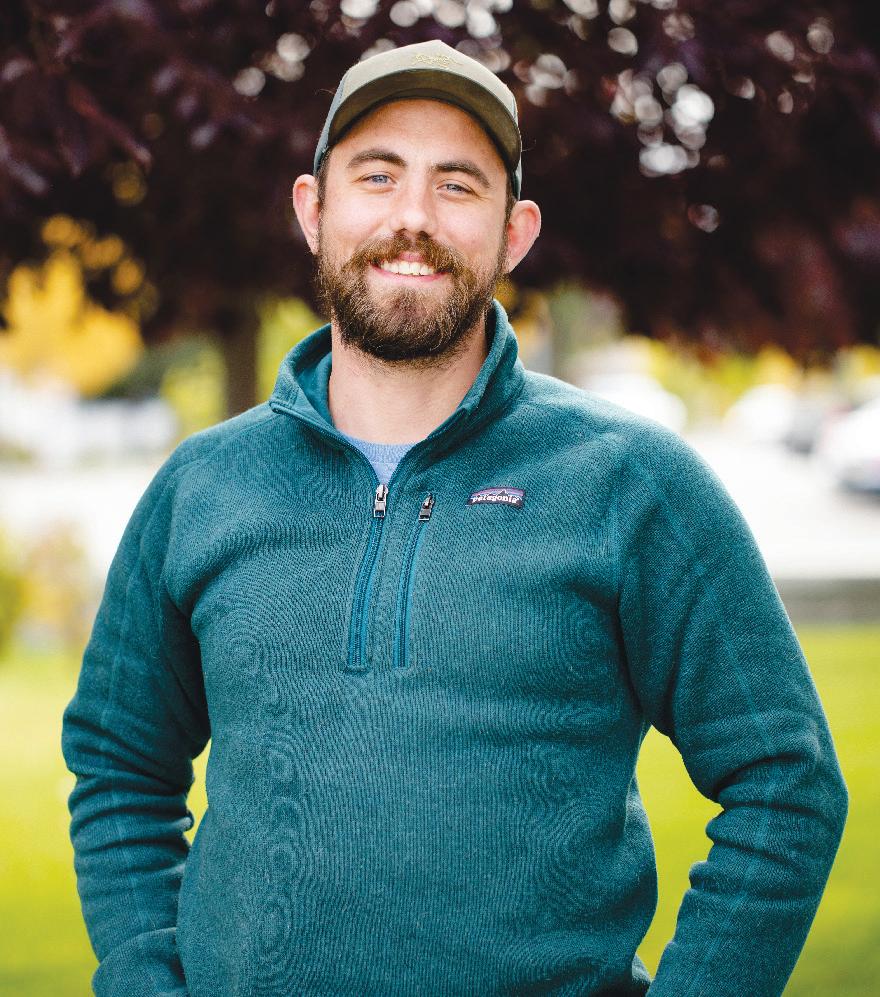
As a system analyst, Todd and his team identify potential and existing issues within the integrated programs, processes and devices that comprise the GVEA framework; analyze the issue to figure out its cause; and develop a way to fix it. He says this is very different than his work as a computer programmer. In that position, he coded in several programming languages to make a program function in specific ways.
“Most people are pretty familiar with the term ‘codemonkey’ to describe programmers who turn out massive lines of code,” Todd says. “A system analyst spends more time diagnosing our internal systems and structure.”
Todd says some of the challenges are pretty unique. The COVID-19 pandemic required on-the-fly adaptation since
many systems weren’t built to accompany the workflow necessary to meet the needs of employees working from home or customers needing a different kind of assistance. However, his favorite project is his current work rebuilding old applications that have acquired technical debt. Reanalyzing and redesigning these software ecosystems will eventually lead to more efficiency for everyone.
“I’m proud of what we’ve accomplished,” Todd says. “A lot of what we’ve done at GVEA is really cutting edge.”
Todd says he’s always looking for new ways to help the people around him. Many of the issues they tackle are significant and affect a wide range of people. However, he says many minor issues are identified while talking with others throughout the day. Sometimes, someone casually mentions having difficulty sending out a notification, pulling a report or retrieving information. Todd says often those are issues he and his department can solve.
“I’d like people to let us know about problems so we can see if it’s something we can work on,” he says. “Not all problems are solvable or cost-efficient to solve, but our department likes new ideas and to develop new ways of doing things.”
Todd says it means a lot to work at GVEA and give back to the community he grew up in. Without power, working and playing in Interior Alaska would be much harder. When Todd isn’t working, he enjoys hunting, fishing, endurance sports and spending time outside in summer and winter. n
MARKETPLACE
Agriculture
Reinforced custom-sized pond liners (39 cents/sqft). Hay covers, greenhouse covers, any width and length. Truck tarps and more. High puncture and tear strength. Best price guaranteed. Celebrating 43 years in business. www.btlliners.com. 541-447-0712.
Antiques and Collectibles
Buying antiques and collectibles: advertising signs, porcelain signs, gas pumps, beer signs, antique toys, cast-iron coin banks, neon signs and more. Jason, 503-310-3321 or tjabaughman@yahoo.com. 0325
Buying American Indian collectibles, Navajo blankets and rugs, baskets, beadwork, etc. Also, quality paintings of the early Southwest and Americas. Call 760-409-3117 or send photos to amer.ind.baskets@gmail.com. 1124
Automotive
‘66 and ‘67 Ford 2-door hardtop Fairlane 500s 289 V8, auto, straight, good glass, titles, project cars. ‘66 runs. ‘67 new upholstery. $5.5K each or $10K for both. LaGrande, OR. 541-663-9091. 1124
Business Opportunities
For sale: quaint hardware store in Maupin, OR. Inventory and interior store recently updated and refreshed. See ad on Bizbuysell.com or email Maupincountrystore@gmail.com. $239,999. 1124
Community Events
Art Center East’s 16th Annual “Handmade Holidays Makers Market” 4-8 p.m. Nov. 15 and 9 a.m.-3 p.m. Nov. 16 in La Grande, OR. artcentereast.org. 1124
Farm Equipment
Two 1937 rare co-op tractors. #2, #3 1952. $900 for both. $1.7K, 1959. 691 $2K. 208-507-1211. 1124
Free Items
Free materials—church, government uniting, suppressing “religious liberty,” enforcing National Sunday Law. Be informed. Need mailing address only. TBS, P.O. Box 374, Ellijay, GA 30540. tbsmads@yahoo.com; 888-211-1715. 1224AR
Help Wanted
The Cape Blanco Heritage Society needs volunteers at the Cape Blanco Lighthouse Greeting Center and Hughes House for 2024 and 2025. Background checks are required. Free RV hookups are available to volunteers. heritage32@frontier.com; 541-332-0521. 1124
Quick, Affordable: How to Place an Ad
Ads 25 words or fewer are $35 a month. An extended ad of up to 35 words is $50 a month. Contact information is included in the word count. Phone numbers and emails count as one word.
Longer ads may be placed. Contact 503-357-2105 or info@pioneer.coop for pricing information.
Ads are for customers of member co-ops, public utility districts and municipals only. Subscribers and nonmembers may inquire about pricing at 503-357-2105 or info@pioneer.coop.
Ads must be direct and in first person, and are subject to approval and editing.
Closing deadlines (in our office): January issue—Nov. 30, 2024.
If submitting ad by mail, send appropriate payment with your name, address, email, phone number and the name of the electric utility that provides your magazine to: Marketplace, P.O. Box 1306, North Plains, OR 97133. Make check or money order payable to Ruralite.
We accept credit card payments for ads submitted by email. Send ad to info@pioneer.coop.
Call 503-357-2105 to pay by credit card.
Advertisements are accepted in good faith. Pioneer Utility Resources is not liable for interactions between buyers and sellers.
Hobbies, Gifts, Games
Santa letters and cheerful artwork for gift giving and holidays, made in Alaska. We ship high-quality gifts and custom artwork, including letter bundles, totes, jewelry, prints, cards, relief prints, tiles. GV11 saves 10%. www.PamelaSueArtandDesigns.com. 1124
Miscellaneous
Local commercial fisherman sells summer catch of preserved freshness by blast freezing at sea, gourmet canned tuna on internet. Sept.June. 100% guaranteed the best canned tuna you ever tasted. Original, jalapeno and garlic flavors available. To order: twofisherstuna.com or call 206-799-1082. 1124
Granite cemetery markers at affordable prices. Will ship to most places. For more info: Joe, highdesertmemorials@gmail.com or 541-815-8906; www.highdesertmemorials.com.
Alaskan yellow cedar. Great for planter boxes, herb and flower beds, fencing or decks. Various sizes available. Pete, 541-206-0727. Lisa, 541-747-5025, ext. 21. 1224
Real Estate
Let me help you buy or sell ranch, farm and recreation property in OR. Fourth-generation Oregonian, prior ranch owner. For sale: Sisters, OR. 40 acres. Price reduced. $1.55M. John Gill, 541-480-9161 or johngill@landandwildlife.com. Land And Wildlife brokerage. 1124
Dale store. Live or work in a recreational enthusiasts’ location, store, fuel, post office, home, game cooler. $325K. Duke Warner Realty, 541-987-2363 or ddwr@ortelco.net.
Last chance to get an undeveloped buildable lot (8,000 sqft.) in Sportsman’s Park (Wasco County, Tygh Valley, OR). Sewer to property line, water on property, power available. National forest on backside. 7 miles to Wamic. $86.6K. Eric, 971-370-0220. 1124
Become an instant Nevadan. Wells: Fully equipped, nonoperating, Bar/Grill, 479 6th St., $395K. 3/2 home, 1355 Lake Ave., $230K. 160 acres with water rights and structures, $160k. Goldfield, ruins of Catholic Church, $65K. Pahrump, Resort Membership $1.8K. kisciniello@yahoo.com; 775-550-2263. 1124
Your ad could be here in January. See instructions above for details.

Newly renovated house in 55-plus community. Peaceful, park-like setting. Great location just minutes from downtown Astoria. 1 bd, 1 ba, country kitchen and cozy living room. $1.6K/ month. 900 sqft. 503-307-7875. 1124
320 acres east of Adel, OR. Borders Hart Mountain views, Steens Mountain and Beaty Butte. Landowner tags, very rural. $263K. For maps, contact thejugglingman3@gmail.com; 541-659-1573. 1124
Recreational Rentals
Bend country cabin. Very clean and fully furnished cabin on private ranch. Close to recreation areas. Very nice. $95/night. 541-382-3050; bendcountrycabins@gmail.com. 1124
Getaway at either of our Airbnb’s here in Lenore, ID. We are on the Clearwater River, so great fishing and hiking. See www.bearcountrygetaways.com. Hope to see you. Cindy and Rocky Wines. 1124
Bed and Birds; a guesthouse. Very private. Wet meadows, range, forest, dark sky, lakeview. Explore or ride? Near ski hill. Reasonable. 541-219-2044. 1124
Recreational Vehicles
Forest River Sunseeker 24, 2016. Good condition. 58,200 miles. 8-ft. slide out with dinette. Seats 4, sleeps 6. $53.9K. OBO. tedbcsc1948@gmail.com; 458-910-3727.
Services
Dawn Till Dusk Masonry. Brick, block, stone and pavers. Small jobs and repairs welcome. Check out our website at dawntillduskconstructionmasonry.com. 541-388-7605; 541-410-6945. License #245760 bonded and insured. La Pine, OR. 1124
We all want delicious, fresh, nourishing food to feed our families. We’ve got pastured pork corn-/soy-/GMO-free. Delivery to your door or drop sites. Order at www.rural-roots-ranch.com or text Christy at 541-589-4674. 1224
Want to Buy
Wanted: 1967-’72 Buick Skylark, GS, Stage 1, GSX. Cars, parts or leads. Or any ’60s or ’70s vehicles. billybibbett@hotmail.com. 1124
Old carpenter tools, planes (wood/metal), levels, chisels, slicks, adzes, axes, hatchets, handsaws, old rulers, spoke shaves, wrenches, shipwright tools, old tool chests. 503-659-0009 or 971-666-0659. 1124
Gold, silver, coins/currency, buy, sell. Collections wanted. Fair prices paid. 44 years in retail store. Baker City, OR. 800-556-2133; garrymclin@aol.com. 1125
Buying American Indian collectibles, Navajo blankets and rugs, baskets, beadwork, etc. Also, quality paintings of the early Southwest and Americas. Call 760-409-3117 or send photos to amer.ind.baskets@gmail.com. 1124
Retired couple wants to buy older Bigfoot or Northern Lite truck camper in good condition. 406-827-3447; montanagirl@blackfoot.net.

Best Breads Cookbook
Who can resist the aroma of homemade bread baking in the oven? Try your hand at more than 400 mouth-watering recipes submitted by readers. This 8½-by-11-inc, indexed cookbook features yeast breads, quick breads, scones and specialty breads for $10 (includes postage).
TO ORDER BY MAIL:


Submit payment with cookbook title, your name, address and number of cookbooks wanted to: Ruralite Cookbooks P.O. Box 1306 North Plains, OR 97133
TO PAY BY PHONE: Call 503-357-2105 for credit card payments with Visa, MasterCard, Discover or American Express.
TO ORDER ONLINE: Visit www.ruralite.com.
Please allow two to three weeks for delivery.
360-832-4021 Home: 360-832-4562 Pastor Bernard Preston Ritchea Cell: 361-330-9666 Facebook: Eatonville United Methodist Church of Washington OPEN HEARTS OPEN MINDS OPEN DOORS OPEN TABLE WORSHIP SERVICE BEGINS AT 10:30
Success After Service
Transitioning to civilian careers post-military
By Rachael Kvapil
Veteran’s Day holds a special place in Al Rottnek’s heart. Growing up in a military family and later serving, Al understands how important community is when transferring from military to civilian life. GVEA has played a significant role in Al’s post-military life since 1992, providing focus and opportunities to enhance his career and find stability in this stage of his life.
“When I got out of the military, I wanted to find a company like GVEA that offered stability, good pay and benefits,” Al says. “Those were the biggest things.”
After high school, Al followed in his stepfather’s footsteps and joined the Air Force. He requested to return to Germany, where he attended high school, but was sent to Eielson Air Force Base instead. He worked in all areas of accounting and
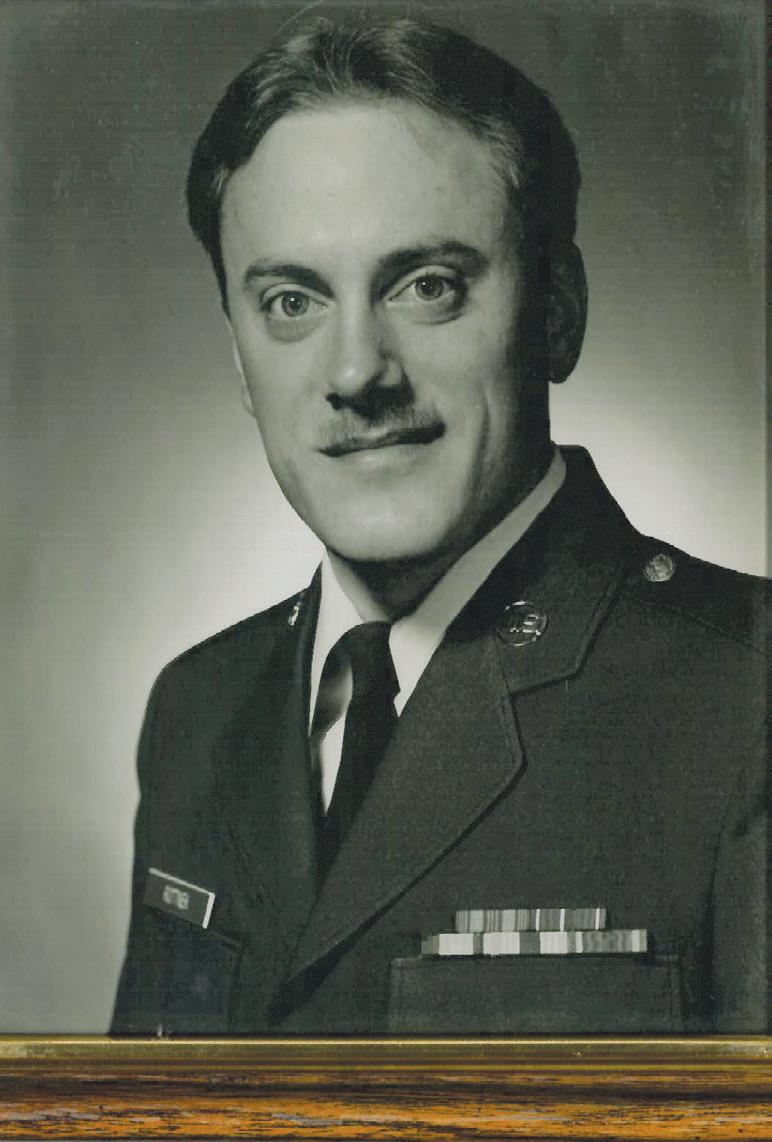
finance during his more than six years of active duty. By then, he had met his wife and decided they didn’t want to move anywhere else because she already had an established career in Fairbanks.
When Al separated from the military in 1991, programs to assist with the transition to civilian life weren’t yet developed. Al remembers the first seven months of civilian life as rough. He spent a lot of time with the Alaska Job Center and the now-defunct Private Industry Council looking for work. After two short-term jobs, he took a position at GVEA. Thirty-two years later, he is still with the company. Al’s difficulty transferring to civilian life is not unusual. The year Al separated from the military was the same year Congress established the Transition Assistance Program as part of the National Defense Authorization Act. The program was created to

Al Rottnek, GVEA employee and Air Force veteran, reflects on the value of stability and community in his post-military career.
help service members and their families transition from military to civilian life. TAP is led by the U.S. Department of Defense and partnered with the Departments of Labor, Veterans Affairs, Homeland Security, and Education; the U.S. Office of Personal Management, and the U.S. Small Business Administration. In the early days, the program was optional for transitioning military personnel, but it became mandatory in 2011.
“We want to set up our soldiers for success following their time in the military,” says Janice Westlind, U.S. Army Garrison Alaska deputy transition services manager for TAP.
Before, each military service had its own form of transition services and programs; however, now all follow the TAP format. Starting in 2019, service members are required to begin the TAP process no later than 365 days before separation, retirement or release from active duty. The core components of the TAP curriculum are Individualized Initial Counseling, Pre-separation Counseling, The DoD Transition Day, VA Benefits and Services, Department of Labor Employment Fundamentals of Career Transition, Service Member Elected Tracks and Capstone. Classes are open to all military spouses during this time frame as well.
“These classes cover resume writing, job interviews, starting a business, managing education, career assessment, financial planning and more,” Janice says. “The main purpose is to assist soldiers in finding employment, attending college or setting them up on a business track when they get out.”
Among the many programs, soldiers can also take part in a Career Skills Program that offers on-the-job training via a four-month paid internship with a local
company. The military funds the internship and comes with no extra costs to the company. She adds that different services work with different companies and use different metrics with the Career Skills Program.
Al has found significant success despite not having a formalized transition program to assist him. During his time at GVEA, he acquired three associate and a bachelor’s degrees as he explored other potential positions within the company. When he started his educational journey, the University of Alaska Fairbanks didn’t offer a degree in applied management. So, Al had to coordinate with professors to build an approved curriculum list through an interdisciplinary studies program. It took time and dedication to get his plan approved by the university, and eventually, Al graduated in 2018.

lifestyle with Fort Wainwright Army Post and Eielson Air Force Base nearby.
As a military BRAT, an acronym from 1920s Britain that now applies to all military children, Al says that he and his brothers, who also served in the Navy and the Marines, were introduced to many cultures and all walks of life. He says many life skills are learned living in a military family, and many friendships are made and lost when moving around. Though he is surprised to meet people who have never left Alaska, he says Fairbanksans seem to understand the military
“There are some habits that never leave us,” Al says. “There’s a type of discipline instilled in us that makes us show up early for appointments or to an airport and possess a certain work ethic built on high standards.”
Though Veteran’s Day is on November 11, GVEA observes the holiday on the Friday after Thanksgiving. Offices are closed on that day, giving employees a four-day holiday. n
Help Us Help Your Neighbors
#SleevesUp to donate blood for your community
At Pioneer Utility Resources, the publisher of Ruralite magazine, we are always working to put the right letters together to tell a story. The American Red Cross story can’t be told without three letters: A, B and O, which represent the main blood types. When those important letters are missing from blood bank shelves, lives are at stake.
With the recent hurricanes in Florida adding to the need for blood nationwide, we encourage each of you to consider

Donate between Nov. 18 and Dec. 8, and you could receive two pairs of socks.
Facts About Blood Needs
X Every 2 seconds someone in the U.S. needs blood and or platelets.
X Approximately 29,000 units of red blood cells are needed every day in the U.S.
X Nearly 5,000 units of platelets and 6,500 units of plasma are needed daily in the U.S.
X Sickle cell disease affects 90,000 to 100,000 people in the U.S. About 1,000 babies are born with the disease each year. Sickle cell patients can require blood transfusions throughout their lives.
X According to the American Cancer Society, more than 1.9 million
donating blood by rolling up your sleeves and visiting a local Red Cross donation center between Oct. 25 and Dec. 25. Your gift of blood can save more than one life.
Visit this link—https://rcblood.org/3zJ1rxU—or scan the QR code below. Sign up to help us reach our goal and fill in the missing blood types so patients can receive the lifesaving care they need. Make and keep an appointment to give blood to the American Red Cross. n

https://rcblood.org/3zJ1rxU
people are expected to be diagnosed with cancer in 2025. Many of them will need blood, sometimes daily, during their chemotherapy treatments.
X Nearly 16 million blood components are transfused each year in the U.S.
X The average red blood cell transfusion is approximately 3 units.
X A single-car accident victim can require as many as 100 units of blood.
X Blood and platelets cannot be manufactured; they can only come from volunteer donors.
X The blood type most often requested by hospitals is type O.
X One donation can help save more than one life.


With more than 200 recipes, this cookbook from our 2007 contest offers options for potlucks, family reunions or picnics. As a bonus, additional pages feature previously unpublished barbecue recipes from a 2006 contest. The 8½-by-11-inch spiral-bound, indexed book is $10 (includes postage).
TO ORDER BY MAIL:
Submit payment with cookbook title, your name, address and number of cookbooks wanted to:
Ruralite Cookbooks
P.O. Box 1306
North Plains, OR 97133
TO PAY BY PHONE: Call 503-357-2105 for credit card payments with Visa, MasterCard, Discover or American Express.
TO ORDER ONLINE: Visit www.ruralite.com.
Please allow two to three weeks for delivery.
Owned By Those We Serve BOARD OF DIRECTORS
Tom DeLong, Chair, District 2
Chris Bunch, Vice Chair, District 5
David Messier, Treasurer, District 1
Gary Newman, Secretary, District 4
Fred Sheen, District 6
Rick Solie, District 3
Krista Zappone, District 7
Corporate Headquarters
758 Illinois St. P.O. Box 71249
Fairbanks, AK 99707-1249
907-452-1151
800-770-GVEA (4832) Fax 907-458-6365
Delta Junction Office 1681 Richardson Highway Delta Junction, AK 99737
907-452-1151
800-770-GVEA (4832) Fax 907-895-5472
Report Outages:
907-452-1151
800-770-GVEA (4832)
Select: Option 1, Option 1
View Outage Map: gvea.com/outages
www.gvea.com
AK-37

It Pays to Be a Member
By the end of November, Golden Valley Electric Association will return $6.9 million in capital credits to members who had service with the cooperative in 1999 or earlier.
One advantage of being a member of a cooperative is having service provided to memberowners at cost. Because GVEA is a not-for-profit cooperative, any revenue leftover at the end of each year (known as margins) is allocated to members based on the amount of power bought throughout that year. These funds, known as capital credits, are returned to GVEA members based on their electric service purchases.
While allocation of capital credits happens each year, the co-op typically retains this money for 25 years. During this time, capital credits are reinvested in the system for projects and maintenance, such as building substations or replacing power poles or lines. GVEA’s board of directors specifically authorizes each retirement only after careful consideration of the financial impact to the co-op. When capital credits are retired, GVEA issues a return.
Active members whose refunds are less than $100 have a credit posted to their membership account. Active members with capital credit refunds of $100 or greater are issued a check. However, active members with a past due or delinquent balance have their entire capital credit refund applied to their membership account. Former members receive checks if balances exceed $25 (or less than $25 and held for five years).
For more information about capital credits and a list of frequently asked questions, visit www.gvea.com/capital-credits. Direct questions to capitalcredits@gvea.com or call 907-451-5625.
How it works
